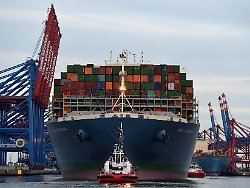Monday, August 16, 2021
USA and China rush forward
Germany is left behind when it comes to buying hamsters
In the US and China, companies are restocking on a large scale. This started later in Germany – and companies now have to pay higher and higher prices.
The economic boom after the Corona recession is leading to hamster purchases by companies around the world. European and, above all, German companies are often left behind, while the USA is ahead in the race for the coveted supplies. That is the result of a world trade study by the credit insurer Euler Hermes.
The disproportion is explained by the non-simultaneous recovery from the consequences of the lockdowns. The US economy picked up again much earlier and more powerfully than in Europe. The result: deliveries of goods from China to the USA are currently increasing by around 30 percent over the year, compared to only around 10 percent to Europe.
“Hamster purchases are currently in global trade,” said the head of Euler Hermes in Germany, Austria and Switzerland, Ron van het Hof. “However, the US is clearly ahead in the race for the goods – partly because of the earlier reopening.” Companies everywhere tried desperately to replenish their stocks. “This is currently not a sure-fire success: In view of the ongoing bottlenecks in the supply chain, especially in the shipping containers themselves, and the longest delays in a decade, the prices and thus the costs of world trade are rising at a gallop to new record highs.” In this situation, most European countries, and especially Germany, would find it difficult to replenish their already low stocks.
According to the study by the Allianz subsidiary, world trade has recovered surprisingly quickly and strongly in the current year. For the year as a whole, the economists at Euler Hermes are anticipating an increase of 7.7 percent in the volume of goods and services traded worldwide, after a decrease of 8 percent in the previous year. Due to significant price increases, retail should increase in value by as much as 15.9 percent, after a minus of 9.9 percent in 2020.
Scarce ship capacities
The slump in supply and demand was the driver behind the slump in world trade in 2020, the economists wrote. “For this year’s increase in the value of traded goods and services, however, the normalization of supply and demand conditions only accounts for around 15 percent – the increase in inventories, on the other hand, is around 50 percent.”
The scarce ship capacities with higher prices therefore make up around 35 percent. Container shipping companies are currently charging sharply rising prices for global freight transports, around 90 percent of which are carried out by sea. “Ship capacities are likely to remain scarce in the short term,” said van het Hof. “Reasons for this are, in addition to the regionally very uneven upswing, the inadequate investment in shipping in recent years.” Because transport capacities cannot be increased at short notice, he – like shipping companies themselves – expects further bottlenecks until 2022.
.
